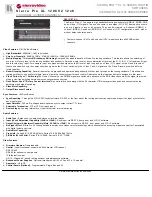
IP Multicast Overview
195
possible for multicast. The multicast application sends the packets to a group of
receivers (as with multicast addresses) who are ready to receive the data but not
only to one receiver (as with unicast address).
The multicast routing creates a loop-free data transmission path from one data
source to multiple receivers. The task of the multicast routing protocol is to create
a distribution tree architecture. A multicast router can use multiple methods to
build up a path for data transmission, i.e., the distribution tree.
■
PIM-DM (Protocol-Independent Multicast Dense Mode, PIM-DM)
PIM dense mode is suitable for small networks. It assumes that each subnet in
the network contains at least one receiver who is interested in the multicast
source. Multicast packets are flooded to all points of the network. Subsequent
resources (such as bandwidth and CPU of routers) are consumed. In order to
decrease the consumption of these precious network resources, branches that
do not have members send Prune messages toward the source to reduce the
unwanted/unnecessary traffic. To enable the receivers to receive multicast data
streams, the pruned branches can be restored periodically to a forwarding
state. To reduce latency time, the PIM dense mode uses the prune mechanism
to actively restore multicast packet forwarding. The periodical flood and prune
are characteristics of PIM dense mode. Generally, the forwarding path in dense
mode is a “source tree” rooted at the source with multicast members as the
branches. Since the source tree uses the shortest path from the multicast
source and the receiver, it is also called the shortest path tree (SPT).
■
PIM-SM (Protocol-Independent Multicast Sparse Mode, PIM-SM)
Dense mode uses the flood-prune technology, which is not applicable for
WAN. In WAN, multicast receivers are sparse and therefore the sparse mode is
used. In sparse mode, hosts need not receive multicast packets unless, by
default, there is an explicit request for the packets. A multicast router must
send a join message to the RP (Rendezvous Point, which needs to be built into
the network and is a virtual place for data exchange) corresponding to the
group for receiving the multicast data traffic from the specified group. The join
message passes routers and finally reaches the root, i.e., the RP. The join
message becomes a branch of the shared tree. In PIM sparse mode, multicast
packets are sent to the RP first, and then are forwarded along the shared tree
rooted at the RP and with members as the branches. To prevent the branches
of the shared tree from being deleted, PIM sparse mode sends join messages to
branches periodically to maintain the multicast distribution tree.
To send data to the specified address, senders register with the RP first before
forwarding data to the RP. When the data reaches the RP, the multicast packets
are replicated and sent to receivers along the path of the distribution tree.
Replication only happens at the branches of the distribution tree. This process
can be repeated automatically until the packets reach the destination.
Forwarding IP Multicast
Packets
In the multicast model, the source host sends information to the host group
represented by the multicast group address within the destination address fields of
the IP packets. The multicast model must forward multicast packets to multiple
external interfaces so that the packets can be forwarded to all receivers.
■
RPF (Reverse Path Forwarding)
To ensure that a multicast packet reaches the router along the shortest path,
the multicast must depend on the unicast routing table or a unicast routing
Содержание Switch 7700
Страница 10: ...2 ABOUT THIS GUIDE ...
Страница 52: ...44 CHAPTER 2 PORT CONFIGURATION ...
Страница 194: ...186 CHAPTER 5 IP ROUTING PROTOCOL OPERATION ...
Страница 195: ...Route Capacity 187 ...
Страница 196: ...188 CHAPTER 5 IP ROUTING PROTOCOL OPERATION ...
Страница 197: ...Route Capacity 189 ...
Страница 198: ...190 CHAPTER 5 IP ROUTING PROTOCOL OPERATION ...
Страница 237: ...GMRP 229 SW7700 Ethernet1 0 1 gmrp ...
Страница 238: ...230 CHAPTER 6 MULTICAST PROTOCOL ...
Страница 270: ...262 CHAPTER 7 QOS OPERATION ...
Страница 320: ...312 CHAPTER 9 AAA AND RADIUS OPERATION ...
Страница 330: ...322 CHAPTER 10 RELIABILITY ...
Страница 390: ...382 CHAPTER 11 SYSTEM MANAGEMENT ...
















































